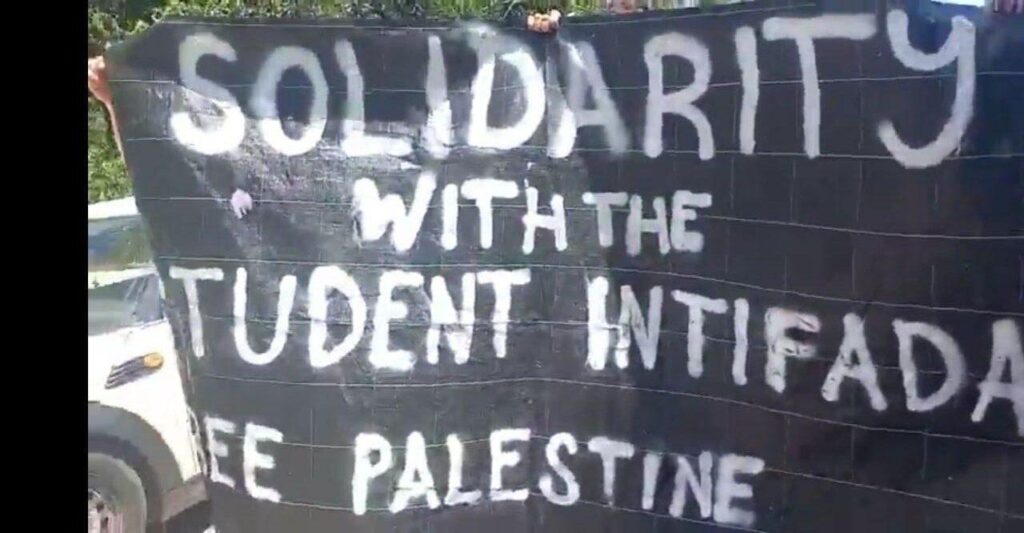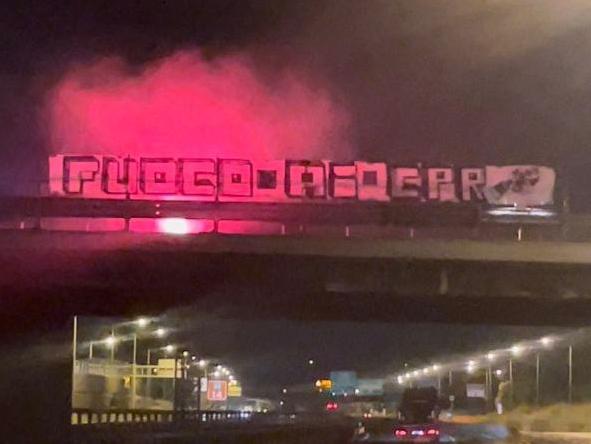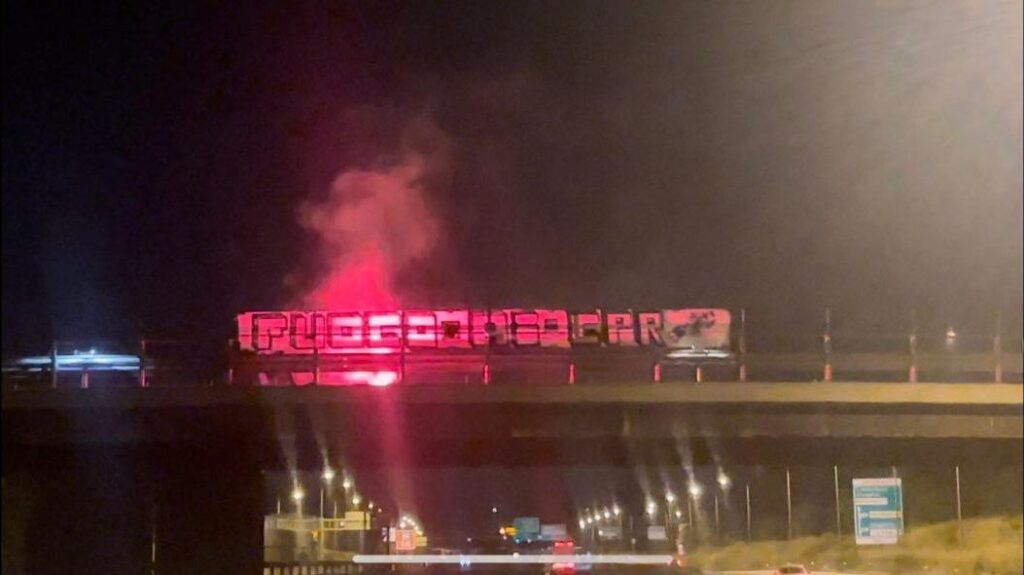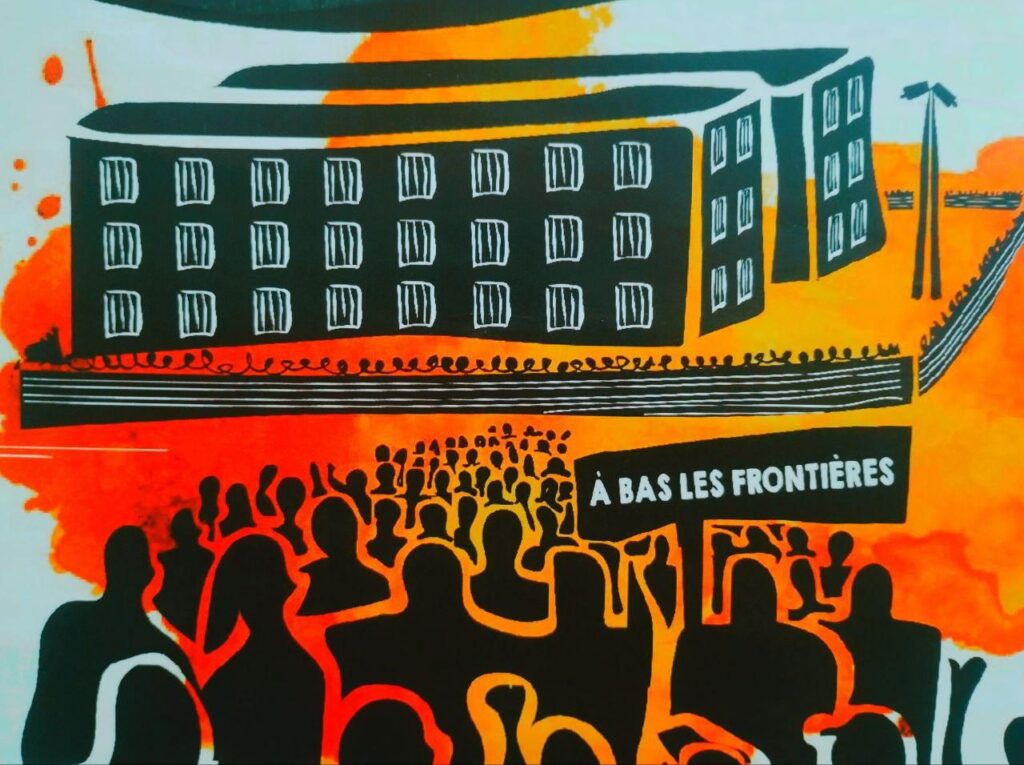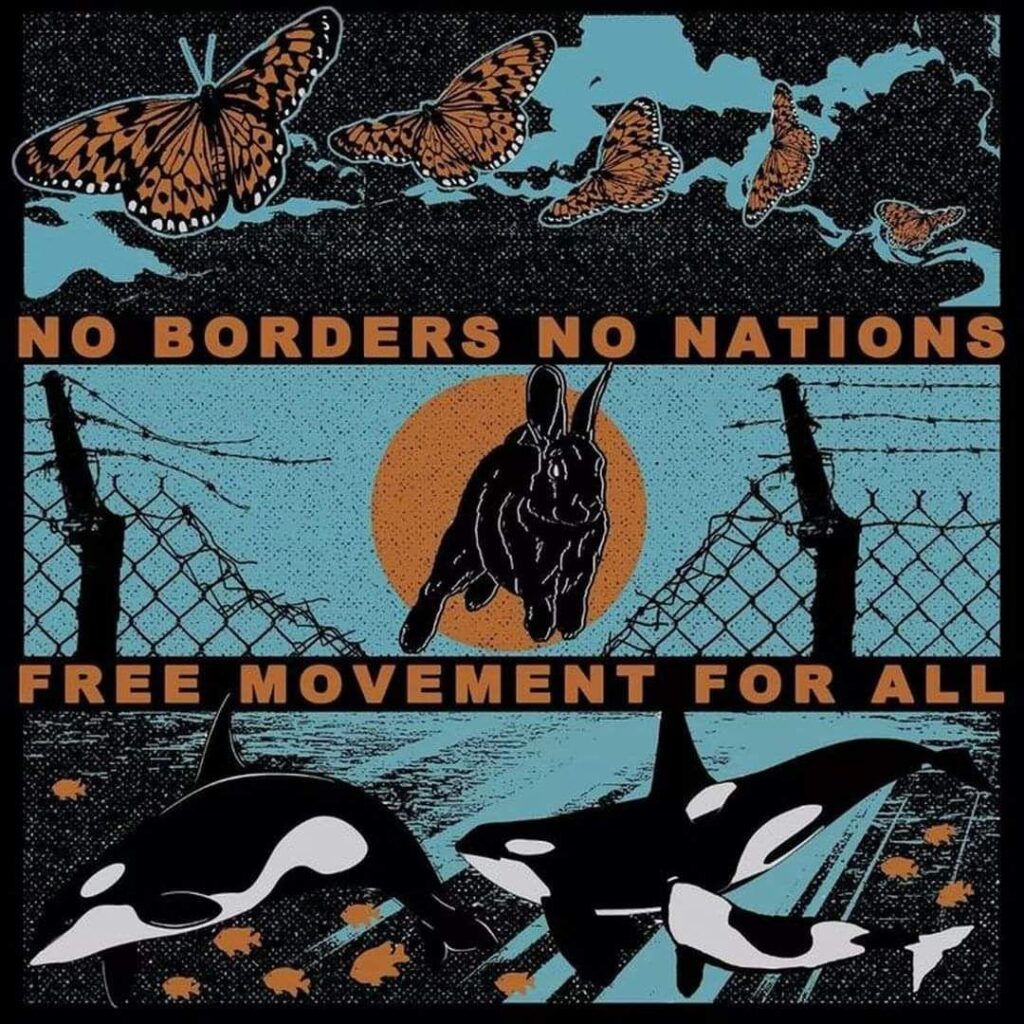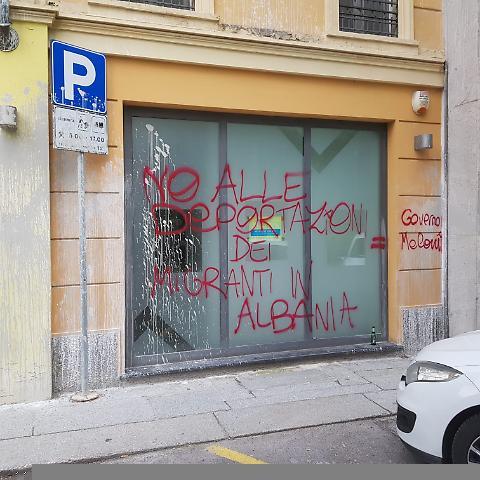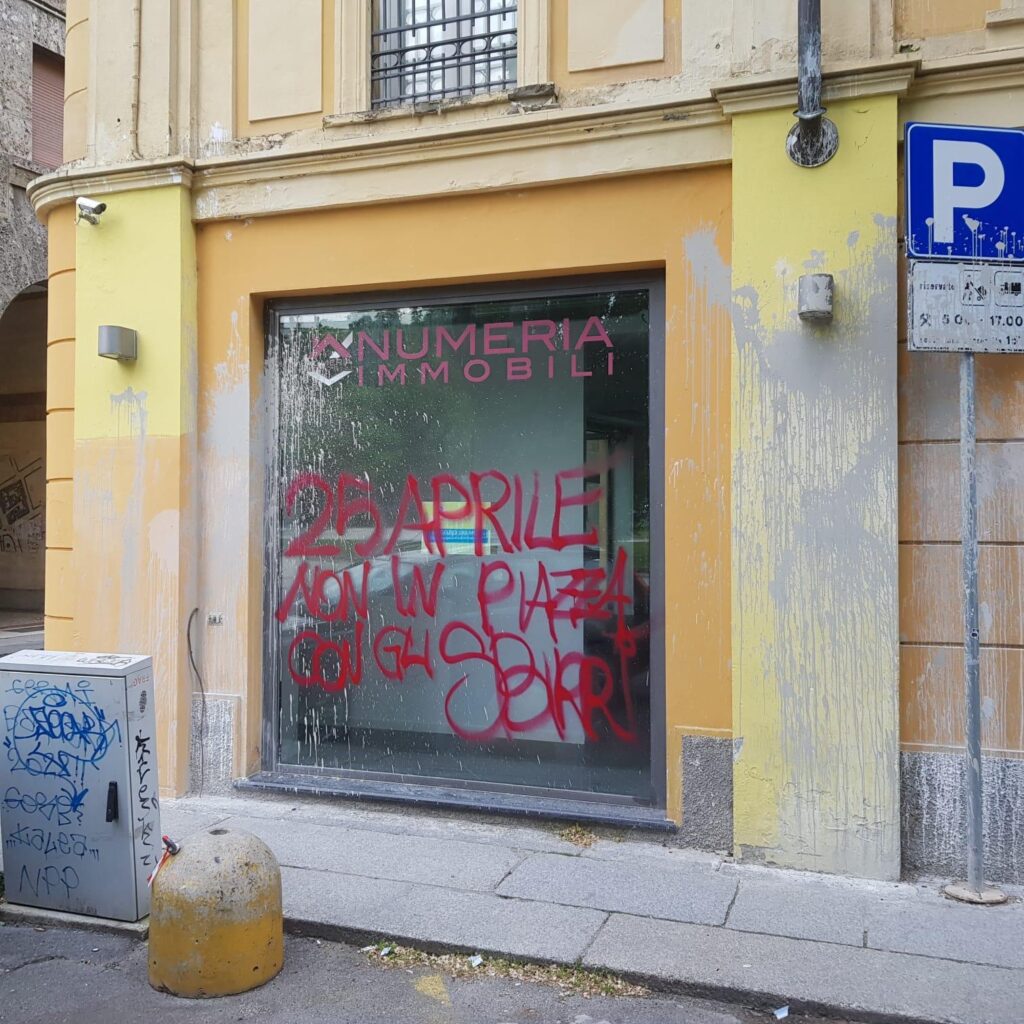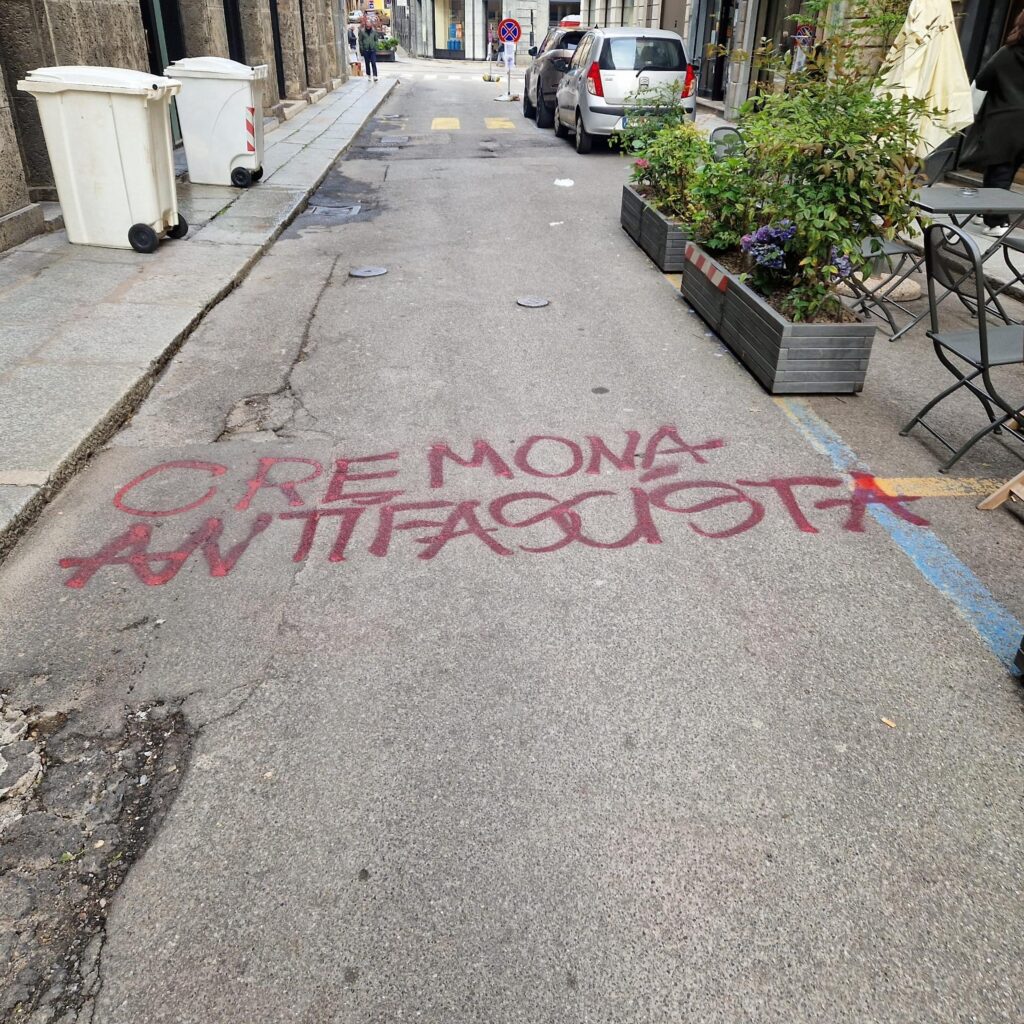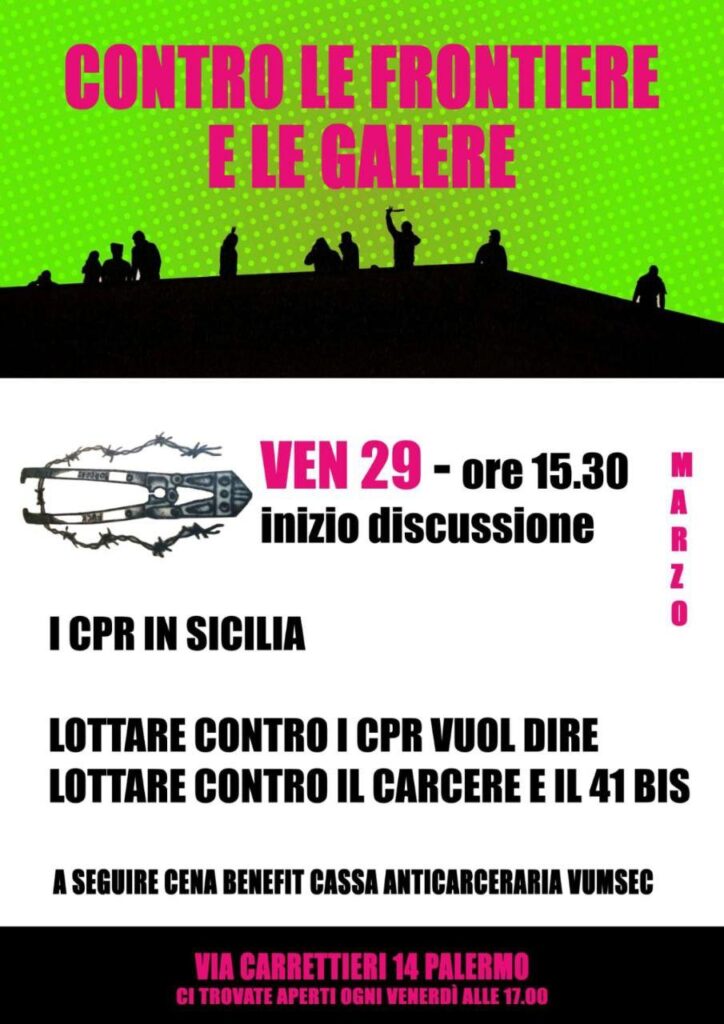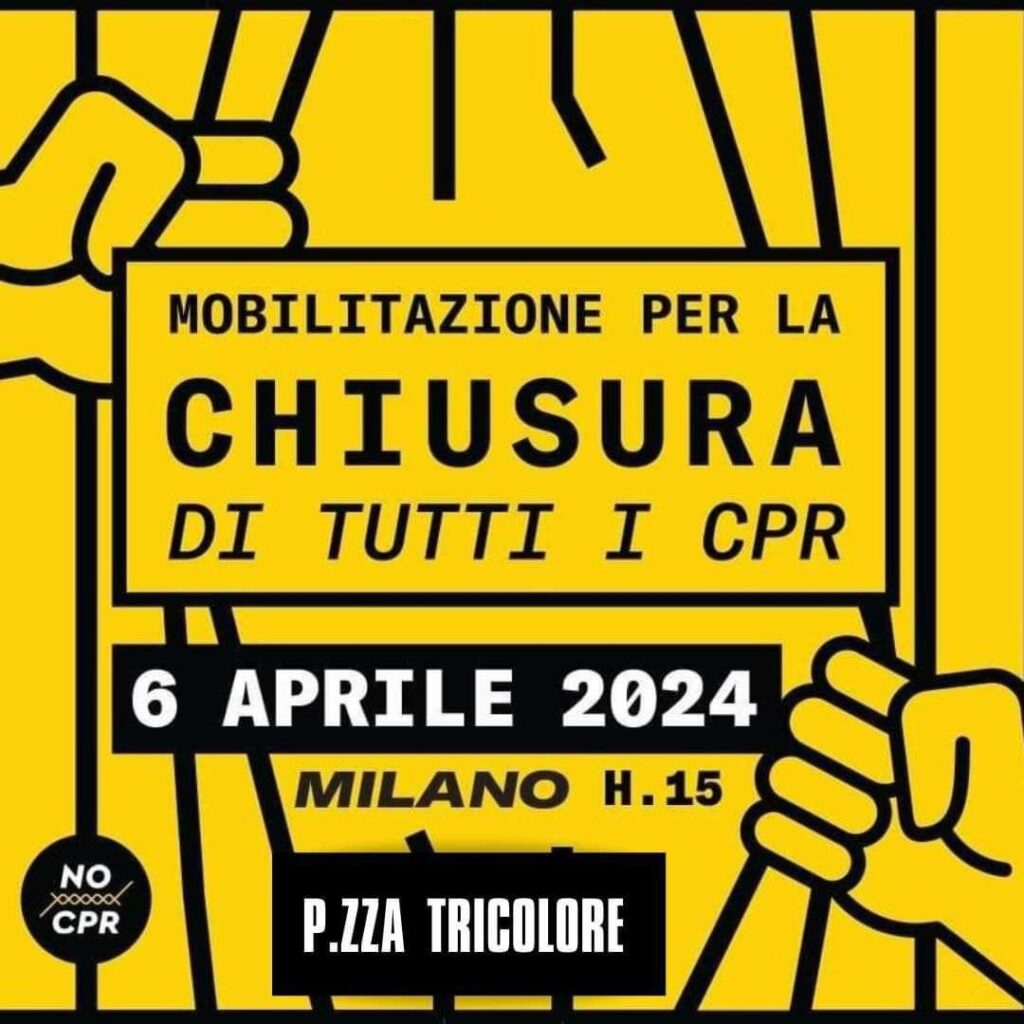
Diffondiamo da Sicilia Noborder:
“Il nemico è potenzialmente chiunque”
Sabato 18 maggio, in occasione del corteo a Villa San Giovanni contro il progetto di costruzione del ponte sullo Stretto, sono apparsi degli striscioni in sostegno alla resistenza del popolo palestinese; in solidarietà ad un gruppo di compagnx in detenzione amministrativa in Grecia, inflitta a seguito dell’occupazione dell’Università di Atene in sostegno alla lotta di liberazione palestinese; ed infine, uno che chiama in causa le responsabilità di ‘Medihospes’, gestrice dell’hotspot di Messina, nelle colonie penali che il governo italiano ha iniziato a costruire in Albania. È infatti impossibile scollegare tra loro detenzione, invasione militare e costruzione di infrastrutture e ‘grandi opere’.
Come siano intrinsecamente collegati tali dispositivi e collaborino tra loro nell’espansione delle ‘frontiere del capitale’ risulta evidente dal manifestarsi dei più ovvi interessi economici che si malcelano dietro azioni repressive e d’invasione. Infatti, esternalizzazione delle frontiere, localizzazione forzata di persone e presenza di presidi militari a diverse latitudini non sono altro che la manifestazione più materiale dell’alito cancerogeno di sua maestà il capitalismo, cui metastasi sono anche lo Stato e il braccio armato da questo costituito al fine di mantenerne in forze il potere esecutivo.
Le politiche di morte e colonialismo che il progetto ponte prospetta e rappresenta non riguardano soltanto i territori dello Stretto. Non ci si può, infatti, soffermare solo sulla realizzazione del manufatto, ma bisogna anche tenere bene a mente le prospettive di guerra attraverso le quali si giustifica la costruzione dello stesso (“interesse militare”). Risulta sempre più evidente che l’estrazione di valore ad ogni costo non desideri incontrare opposizioni; arrogandosi la detenzione del ‘vero’ e del ‘giusto’, la loro tecnica vuole imporre un nuovo modo di concepirsi, un nuovo modo di viversi e di pensarsi. Tutti volti alla totale sottomissione a quello che viene definito come ‘interesse pubblico’, che è in reltà la chiara visione di chi concepisce lo spazio come qualcosa da conquistare e le persone come macchine o scarti di cui disporre a propria volontà. Basti pensare a tutta la scia di sangue che le società che oggi costituiscono ‘WeBuild’, hanno sparso e continuano a spargere da decenni dall’Africa all’America Latina. Dove le mega-opere, di carattere prevalentemente idro-elettrico, delle quali la società vanta la costruzione nel suo curriculum, hanno dapprima cacciato, volenti o nolenti, persone che da generazioni abitavano quei luoghi; e, immediatamente dalla messa in opera di queste infrastrutture, compromesso l’habitat rendendolo inabitabile ad ogni sorta di essere vivente.
Cantierizzazioni, cemento a tutto spiano, contaminazione delle acque, deviazione dei flussi idrici e ogni altra sorta di devastazione sono stati tutti garantiti e protetti dal fucile di eserciti, polizie e contractors; e da emendamenti e leggi dei governi di quelle nazioni che svendevano terre e persone a questo mostro vorace. llo stesso modo, manganellate, lacrimogeni e processi fanno da macete nei sentieri impervi della conquista targata TAV o TAC; come anche centri di detenzione, colonie penali e motovedette fungono da ripulisti e messa a guadagno di persone altrimenti nemiche del loro ‘status quo’, dei loro confini, delle loro barriere. A guardarci bene il modello che si replica è sempre lo stesso, un concatemento d’azioni sull’esistente e sulle esistenze tutto volto al guadagno, che nel suo porsi in atto produce e riproduce repressione, morte e devastazione apparentemente irreversibile.
Non ci si poteva certo immaginare che esistesse legge prodotta da un qualunque Stato in difesa degli espropriati; ad essere tutelato, infatti, è sempre l’espropriante. Ma questo la gente lo sa, nonostante ancora la mano tremolante mendichi talvolta tutela da parte del proprio boia, molte esistenze si ribellano, si rivoltano. Lo dimostrano le strade delle città nel mondo, lo dimostrano le colonne di fumo nero che si ergono dai centri di permanenza per il rimpatrio, lo dimostrano le università occupate, le rivolte nelle galere, le frontiere violate, lo dimostra ogni sguardo incendiario, ogni nuova affinità insorgente.
Vecchi e nuovi orizzonti detentivi #1 I Cpr e la Palestina
Colonialismo e guerre diffuse sono il trait d’union di un presente mortifero che ci vogliono imporre dalla Palestina allo Stretto, passando per la Grecia e l’Albania. E chiunque voglia opporsi o anche solo dissenta a queste guerre esterne, chiunque metta in discussione la stabilità degli Stati in guerra e delle loro frontiere, diventa immediatamente un nemico interno da reprimere e criminalizzare. Sempre più diffuse e comuni sono infatti misure cautelari e di incarcerazione che erogano a cuor leggero i PM della nostra ‘cara’ repubblica italiana. Ed è in questo scenario che la detenzione amministrativa sta diventando uno strumento man mano più centrale di repressione, flessibile, immediato, veloce. Rivelando così, anche nella “democratica” Europa, la funzione che ha sempre avuto, sin dalla sua comparsa come strumento del dominio coloniale oltre un secolo fa. Strumento repressivo e genocida infatti, la detenzione amministrativa lo è sempre stata, sin da quando a essere confinate erano le popolazioni ancestrali degli odierni Stati Uniti, i contadini insorti contro il dominio coloniale spagnolo a Cuba, il popolo Herero sterminato dai coloni tedeschi nell’odierna Namibia. Questo elenco insanguinato potrebbe continuare.
Riportando lo sguardo al nostro presente, alcuni episodi di questi ultimi mesi indicano la direzione, in Italia e in tutto l’Occidente, dentro e fuori l’Unione Europea. A ottobre, pochi giorni dopo il sette, Mariam Abu Daqqa, storica leader del Fronte Popolare per la Liberazione della Palestina, è stata fermata dalle forze di polizia a Marsiglia dove si trovava per una conferenza. Le è stata notificato un decreto d’espulsione dal territorio francese, in quanto considerata soggetto pericoloso capace di causare “gravi problemi di ordine pubblico” ed è stata così rinchiusa in un CRA e poi deportata in Egitto. Sulla stessa linea, in Italia, a Febbraio, Seif Bensouibat è stato licenziato dal liceo di Roma dove insegnava. Dopo aver espresso in chat di colleghi il suo sostegno alla resistenza del popolo palestinese, la sua abitazione è stata perquisita dagli agenti della DIGOS, atto giustificato con il pretesto del sospetto di “terrorismo”. Qualche giorno fa, poi, dopo aver organizzato un presidio insieme ad altrx fuori dall’istituto superiore che lo aveva licenziato, Seif è stato raggiunto da un provvedimento di espulsione a seguito della revoca dello status di rifugiato ed è stato così tradotto nel CPR di Ponte Galeria a Roma (da cui per ora è stato rilasciato). Negli stessi giorni della detenzione di Seif, ad Atene l’Università di Economia, occupata in sostegno alla resistenza del popolo palestinese, è stata sgomberata e 28 persone sono state arrestate. Tra lx arrestatx nove, di cittadinanza europea, sono state recluse in regime di detenzione amministrativa nel centro di Amygdaleza, uno dei più letali della Grecia, con la minaccia di deportazione. Qualche mese fa, poi, la macchina della deportazione ha colpito Jamal, un compagno di Torino che da tempo si organizza contro frontiere e galere.
Nonostante evidenti differenze sulla linea del colore, la detenzione sta però chiaramente espandendo la sua funzione di soffocamento del dissenso nell’attuale congiuntura di guerra, consolidandosi come uno strumento di repressione interna adattabile e pronto all’uso, mentre il dissenso viene sempre più connotato come terrorismo (come nel caso del sanzionamento della sede di Palermo della Leonardo spa qualificato come atto terroristico).
D’altronde il dispositivo della detenzione amministrativa trova parte delle sue origini storiche nella catastrofe della costituzione dello stato d’Israele, dove viene sistematicamente usata per tentare di disinnescare la resistenza palestinese.
In Italia, soprattutto al Sud, i CPR hanno sempre asservito il compito di reprimere chi, soprattutto nelle campagne, si organizza e si oppone allo sfruttamento dell’agro-industria; inoltre, da anni contribuiscono alla repressione di chi si mobilita nei diversi settori della logistica contro quelle forme di schiavitù salariata che, data per scontata dai datori di lavoro, varia di intensità in base al gradiente del colore della pelle della persona sfruttata. I Cpr facilitano anche la speculazione che divora i centri storici delle città siciliane, come a Catania e Palermo. Qui, la turistificazione che incontra la lotta al degrado usa le retate e la conseguente detenzione amministrativa per eliminare dallo spazio urbano chi, razzializzatx, si ostina ad esercitare attività di sussistenza informali, sempre più criminalizzate.
La colonia, terra di frontiera, di saccheggio e gerarchizzazione feroce delle vite, è interamente attraversata da caserme, presidi militari e luoghi di detenzione. La Sicilia, per esempio, svolge le funzioni di una vera e propria piattaforma penale, dove l’industria carceraria e più in generale di detenzione prolifera ininterrottamente; solo nell’isola, infatti, vi sono 23 istituti detentivi e 2 CPR (più il CPRI di Pozzallo), 5 hotspots. Crediamo che tanto nelle sue funzioni di “controllo sociale”, quanto in quelle più espressamente deportative, il CPR mira a punire chi con le proprie azioni e il proprio corpo “indesiderato” mette in crisi la sovranità dello Stato, delle sue leggi, delle sue frontiere e delle sue guerre. D’altronde in questi quasi trent’anni di detenzione in Italia, i CPR sono stati attraversati particolarmente da quelle soggettività che più di tutte rappresentano un’eccedenza rispetto all’ordine ed al decoro della società ‘civile’ (spacciatori, criminali, sex workers, senza tetto, rumorosi, clandestini, e via dicendo). Merce perfetta per il mercato punitivo. Un sistema, quello dei CPR, che funziona in perfetta sintonia con quello delle carceri. In particolare in questi giorni, un pensiero non può che andare a tutte le persone rinchiuse nelle patrie galere perché palestinesi (come Ali, Anan e Mansour, rinchiusi con l’accusa di associazione terroristica e deportabili in Israele) o perché accusate di scafismo, ed in particolare a Maysoon Majidi, una donna curdo-iraniana che ha preso parte alle rivolte delle donne in Iran e che ora si trova nel carcere di Castrovillari, dove ha iniziato uno sciopero della fame, ed a Marjan Jamali, donna iraniana rinchiusa nel carcere di Reggio Calabria con le stesse accuse.
Vecchi e nuovi orizzonti detentivi #2 Il Cpr in Albania
Da 25 anni, però, “criminali” ed “eccedenti” distruggono e devastano i centri di detenzione in tutta Europa, e il loro coraggio è la principale forza che ne mette in discussione l’esistenza. E così, in questi giorni, dal centro di Amygadelza 8 compagnx sono uscite, ma la nona è ancora rinchiusa lì dentro, in sciopero della fame assieme alle persone razzializzate che da giorni hanno dato vita ad una serie di proteste. Così è proprio da lì dentro che ci suggeriscono una modalità possibile di opposizione e rivolta a questo sistema detentivo così intrinsicamente coloniale.
A gennaio la rivolta al Cpr di Trapani non solo ha distrutto il 90% della struttura, ma, a seguito dei trasferimenti negli altri Cpr d’Italia, ha innescato una nuova serie di rivolte a Caltanissetta, a Roma (dopo la morte di Ousmane Sylla) e a Gradisca. Incendi, rivolte, fughe. I centri di detenzione in Italia oggi operano a capienza drasticamente ridotta (si parla di 50% dei posti resi inagibili), oppure chiudono, come successo a Torino, grazie al coraggio di chi li dentro vi è stato recluso.
Ed è in questo contesto, che si staglia all’orizzonte la costruzione di nuovi Cpr in Albania. Il piano prevede un hotspot al porto di Shengjin, piccola città in via di turistificazione sulla costa, cinto da mura di quattro metri “per non far vedere cosa succede all’interno” e con tanto di ufficio di Frontex annesso; un centro di prima accoglienza e un Cpr a Gjader, nell’entroterra del paese, nell’area di un ex base militare. Qui sarebbe anche previsto un carcere da 20 posti, per chi oserà ribellarsi. Il tutto sotto la giurisdizione italiana. Italiane sono anche le imprese che stanno guadagnando dalla costruzione di questi centri. I lavori per i prefabbricati di Gjader sono stati affidati alla Ri Group di Lecce, azienda edile che da decenni sparge in giro per il mondo compound e altre strutture per diversi eserciti europei.
Come sempre, lo Stato è protagonista di questa azione tentacolare, imponendo la propria sovranità su un territorio oltre confine; complice delle atrocità commesse da quei secondini, che sono gli enti gestori, aziende senza scrupolo dedite all’accumulo di denaro al costo della vita delle persone. Ad assisterli ci sarà personale di polizia e militare italiano, a differenza di altri lager, come quelli libici, in cui lo Stato italiano ha deciso di versare milioni di euro, in Albania anche i manganelli canteranno l’inno di Mameli. Medihospes, cooperativa di assistenza sociale e sanitaria con sede a Roma, che gestisce l’Hotspot di Messina (oltre a centri d’accoglienza, RSA e altri servizi dell’economia della cura), avrebbe vinto il bando per la gestione del CPR in Albania. Gli “”operatori” di Medihospes saranno inviati per imprigionare uomini e donne nelle moderne colonie penali d’Italia. Giurisdizione italiana, sbirri italiani. Ci finiranno le persone provenienti dai cosiddetti paesi sicuri, la cui lista è appena stata allargata: Albania, Algeria, Costa d’Avorio, Camerun, Egitto, Gambia, Ghana, Marocco, Nigeria, Senegal, Tunisia, Bangladesh e altri paesi dell’area balcanica. Più che paesi sicuri, ci sembrano i paesi di origine di nutrite comunità presenti sul suolo italiano, criminalizzate e spesso refrattarie a farsi assorbire in logiche integrazioniste.
L’esternalizzazione della frontiera europea è in atto da decenni: i muri spinati attorno a Ceuta e Melilla, l’esportazione di biometria e tecnologie di sorveglianza, la cooperazione con le guardie costiere libiche e tunisine, i tentativi di installare avamposti stabili di Frontex nei paesi africani. Le ragioni dell’esternalizzazione sono sicuramente molteplici: tenere lontane le persone dalla ricca Europa, ridurre le loro “tutele legali”, ma allo stesso tempo disciplinare i cosiddetti “paesi terzi” sotto il giogo neocoloniale dei piani di sviluppo, o di un possibile ingresso nell’Unione Europea. Questo è il caso dell’Albania, ma anche quello della Tunisia e, più di recente, dell’Egitto, o quello che si sta cercando di imporre a diversi paesi africani con il nuovo Piano Mattei. Continuare a imporre i tentacoli coloniali della decadente europa, cercare di fermare, in una maniera che non potrà che essere fallimentare, la voglia delle persone di venire a riprendersi ricchezza in quel continente che da secoli impone sulle vite loro e delle loro genealogie sfruttamento, distruzione e asservimento. È questo l’infame ma disperato tentativo italiano e occidentale.
Crediamo, infatti, che alla base di questi più recenti sviluppi (dagli accordi tra Regno Unito e Rwanda fino a quello tra Italia e Albania) ci sia soprattutto la volontà da parte di chi governa di spezzare le catene della rivolta e della solidarietà che si sono date in questi venti e passa anni tra il dentro e il fuori, che rende sempre più difficile tenere aperti i Cpr sul suolo “sovrano”. A maggior ragione in un momento in cui le strade delle città si riempiono di cortei determinati a condannare l’invasione genocida condotta dallo Stato d’Israele ai danni del popolo palestinese. Cortei, ma anche altri momenti di aperta contestazione, che vedono una sempre più nutrita partecipazione di persone arabe, di seconda generazione, figlie di migranti e magari anche persone che hanno in prima persona conosciuto le barbarie della detenzione amministrativa. Nelle piazze, nelle occupazioni, finanche in semplici discussioni ci si rende sempre più conto del ruolo coloniale dello Stato, lo si fa sempre di più attraverso gli occhi, le parole e le azioni di chi quelle frontiere assassine le ha sfidate e continua a farlo ognigiorno.
Esternalizzare non solo l’apparato poliziesco militare che cerca di impedire il movimento, ma anche i centri di detenzione e deportazione per coloro che in qualche modo sono riuscitx a varcarle le frontiere dell’Europa, è dunque un ulteriore tentativo di indebolire la forza della solidarietà, un tentativo di isolare ancora di più le persone recluse, un tentativo la cui efficacia è ancora tutta da dimostrare. Come se le persone albanesi non esistano, non si opporranno a questa invasione militare pacificata sulla loro terra, non mostrano e non mostreranno solidarietà con le persone recluse (che potrebbero essere loro connazionali, tra l’altro) e contro l’Europa fortezza. Come se queste reti non siano già qua, tra Albania e Italia.
Credono di rompere un tessuto di rapporti tra persone che co-spirano, ossia respirano insieme immaginando mondi con una potenza di cui la realtà burocratica di Stati, nazioni, partiti ha paura. Vedranno rafforzarsi connessioni tra dentro e fuori, tra più sponde del Mediterraneo.
Orizzonti di guerra
Il ponte sullo Stretto, come anche la costruzione del CPR in Albania, rappresentano la stessa logica d’invasione e repressione che caratterizza sin dagli albori della ‘modernità’ coloniale il pivot di ogni nazione. Conquista di corpi e territori ed estrazione di profitto: nelle galere e CPR, con l’industria detentiva; nei territori martoriati da trivelle e seppelliti dal cemento; nella terra devastata da pale eoliche e pannelli solari; nei non-luoghi della produzione; nelle città e nelle coste dove il turismo distrugge la biosfera ed espelle glx abitanti. La guerra totale che ci stanno imponendo si alimenta con quanto si lascia avvenire in questa nazione: le industrie belliche italiane fanno profitto sul genocidio in Palestina, sui massacri in Sud sudan e nelle altre guerre che i media nascondono; la marina militare italiana interviene in Yemen; il ponte sullo stretto viene salutato dalla Nato che potrebbe così meglio collegare le sue basi militari; la ricerca pubblica finanzia l’affinamento degli strumenti di morte di Frontex e Israele.
Le ossessive attenzioni nel contrastare le voci di dissenso che si fanno sempre più presenti in giro per il suolo nazionale confermano che la repressione può colpire chiunque e che le distinzioni sono anche distraenti, dannose. Siamo tuttx chiamatx a difenderci dall’esistenza dei confini. Lx compagnx europee che sono state rinchiuse in un CPR greco sono ora marchiate come pericolose sul database SIS di schengen, proprio come avviene per le persone non europee che vengono trovate a varcare o rivarcare i confini esterni e interni dell’Europa. Chi esprime contrarietà alla guerra può ritrovarsi deportatx. Non possiamo dunque considerare l’esistenza di una linea di demarcazione chiara, una netta separazione tra ‘zone di guerra’ e ‘zone di pace’; non possiamo considerare che esistano luoghi veramente esenti dall’agire repressivo di Stato e capitale. Questo, se anche mai sia stato vero, oggi lo è meno che mai. Le formule della repressione vengono apprese da altri Stati ed a sua volta importati all’interno del confine giurisdizionale di altri Stati ancora, questo lo conferma l’apprendistato che il mondo Occidentale fa nell’osservare le formule detentive e coercitive messe in opera dallo Stato sionista, tra le altre cose.
Imprigionare i e le palestinesi, chi si oppone al genocidio e supporta la resistenza è un tentativo di reprimere la forza della solidarietà tra gli oppressi. Esternalizzare, alla stessa maniera, è un tentativo di rompere le maglie della solidarietà tra gli oppressi. Ma come già abbiamo avuto modo di scrivere, questo tentativo di cristallizzare le resistenze, di frammentarle e disseminarle trova la conferma della sua tendenziale inefficenza nei continui momenti di vicinanza e solidarietà allx prigionierx in ogni luogo del mondo. Ogni incarcerazione accresce la determinazione nell’affrontare questa macchina repressiva, che deporta ed uccide.
A questo scenario di guerra dobbiamo continuare ad opporci, a noi il compito di mobilitarci contro tutti i padroni nei nostri territori, a partire dai CPR e chi li gestisce, qui e altrove. Le nemiche di questo regno della definizione gerarchica sono ovunque, i nemici del loro pallido sopravvivere si annidano anch’essi ovunque. La ruggine si è già insinuata negli ingranaggi della loro macchina di tortura.
Lottare al fianco del popolo palestinese è lottare anche per la nostra stessa liberazione!
“Coloro che, quand’anche la libertà fosse interamente persa e bandita da questo mondo, se la figurano e la sentono nel proprio spirito, e l’assaporano e che la servitù disgusta, per quanto bene la s’acconci”– E. La Boétie
Approfondimenti:
– Sul progetto del Ponte: https://nopassaran.noblogs.org/2024/05/cemento-mori/
– Sulle detenzioni in chiave anti-palestinese: https://radioblackout.org/2024/05/prigionieri-per-reati-dopinione/
– Su altri usi della detenzione amministrativa in UE: https://lavampa.noblogs.org/post/2024/05/25/breve-aggiornamento-dalla-grecia-e-riflessioni-a-margine/
– Su altri usi della detenzione amministrativa in Francia: https://www.monitor-italia.it/prevenire-e-punire-altri-usi-della-detenzione-amministrativa/
– Sui Cpr in Albania: https://radioblackout.org/2024/02/arriva-il-via-libera-per-i-cpr-italiani-in-albania/
– Comunicato della compagna in sciopero della fame nel CPR in Grecia: https://www.rivoluzioneanarchica.it/grecia-sciopero-della-fame-per-la-palestina-nel-centro-di-detenzione-di-amygdaleza/

